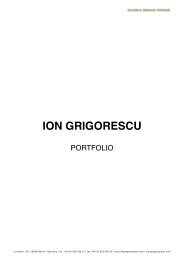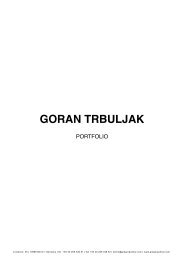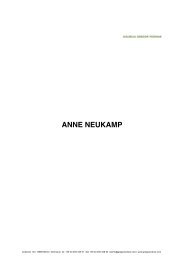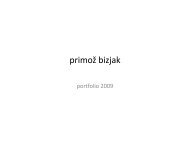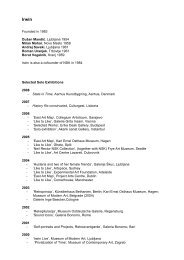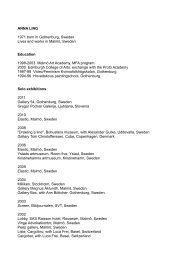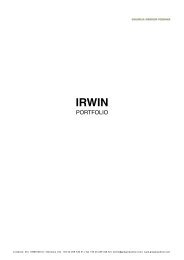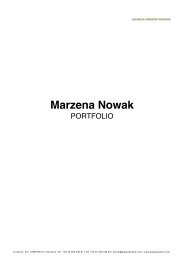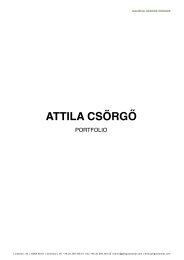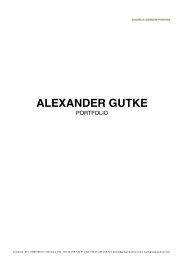GORAN PETERCOL - Galerija Gregor Podnar.
GORAN PETERCOL - Galerija Gregor Podnar.
GORAN PETERCOL - Galerija Gregor Podnar.
Create successful ePaper yourself
Turn your PDF publications into a flip-book with our unique Google optimized e-Paper software.
<strong>GORAN</strong> <strong>PETERCOL</strong><br />
PORTFOLIO<br />
Lindenstr. 35 | 10969 Berlin | Germany | tel. +49 30 259 346 51 | fax +49 30 259 346 52 | berlin@gregorpodnar.com | www.gregorpodnar.com<br />
!
There is no empty space. Within the context of art, space is<br />
a kind of ready-made.<br />
Goran Petercol in conversation with Ivana Sajko, 2002<br />
!
Sjene (shadow)<br />
!
Sjene (40 A)<br />
installation; wire, brass, light variable dimension, brass element: 3 x 150 mm, 1989<br />
At the beginning of the 1980s Goran Petercol staged his first installation, working with found objects - neutral,<br />
unpromising elements such as wire, boards, bricks, rods, and so on - onto which he used spotlights to direct the<br />
flow of light and obtain the element of shadow. This releases a process of what might be termed «organized<br />
randomness» where the first impulse would appear to be followed by the whole series of intentional and aleatory<br />
operations, the former only partially distinct from the latter. On the one hand we have the phenomenon of<br />
spontaneity, unchecked randomness and controlled process, on the other the question of the object and shadow,<br />
the reflection and the image, or drawing with light.<br />
!
Sjene (19)<br />
installation; wire, brass, light, variable dimension, brass element: 3 x 150 mm, 1993<br />
!
Sjene (135)<br />
installation; brass, light, 3 x 300 mm, 1993<br />
The light source is pointing directly on the the metal stick in the wall. The shadow is to be understood as a point or<br />
rather as a progression of the wire-sculpture in the wall.<br />
!
Sjene<br />
Installation - lamp, pipe on pedestal, variable dimension, 1990<br />
Exhibition view at <strong>Galerija</strong> <strong>Gregor</strong> <strong>Podnar</strong>, 2009, and detail<br />
!
Sjene (86)<br />
Metal, wire light,, variable dimension, 1992<br />
!
Sjene (150)<br />
Aluminum, mirrors, approx. 70 x 50 x 25 cm, 1994<br />
Disappearance offers itself as a metaphor. I see disappearance and absence as a matter of quantity. Shadow is a<br />
smaller quantity of light, not its complete absence. Quantity presupposes limitations. For instance, a series is<br />
endless only in the idea; once executed in material, it is merely a part. It is limited by space, gallery, materials..<br />
Each project is limited by the quantity available. By the fact of necessity of break which I build into my work, I take it<br />
out of the context of Constructivism.<br />
Goran Petercol in conversation with Tihomir Milovac, 1994<br />
!
Sjene (155)<br />
installation; brass, light, variable dimension, brass element: 3 x 150 mm, 1998<br />
!
Sjene (113)<br />
Plate, mirrors, approx. 40 x 30 x 15 cm, Second version of three, 1994<br />
!
Enlarged Shadow (for 5cm)<br />
installation (light, brass pipe: l = 15 cm, clay), 10 x 19,5 x 16 cm, 1987/88<br />
In Enlarged Shadows, the shadow is just a base, like a cut form of the surface from which, for instance, I lift the<br />
material to a certain height. They leave the surface. These works are similar to sculptures.<br />
Goran Petercol, Interview with Tihomir Milovac, 1994<br />
!
Negatives<br />
!
Negative (18)<br />
Installation (spotlight, lamp, projection of shape-slide projector), ca. 45 x 40 x 14 cm, 1996<br />
The shadow of an object is a digression, and as such it opens up digressive space: a space of the ability to move<br />
where method continues to find a shelter for its own visibility. Once the shadow is removed, the digressive space<br />
closes, the object is expanded, immobilizing the method and leaving it visible. The method of immobilization in the<br />
field of its own induction. The method of enlightenment in the space of its consequences: in the system where<br />
everything incompatible with the measure of calculation and utility is held suspicious, the system in which the<br />
number has become a canon. Including the number of dimensions which one is allowed to grasp. Petercol’s<br />
Negative makes visible the dimension censored by this system, a dimension of transposition.<br />
Leonida Kovač, Zagreb, 1995<br />
!
Negative (7)<br />
Part of the installation at Croatian Pavillion, Venice Biennale, 1995<br />
Collection: Moderna galerija, Ljubljana<br />
!
Negative (4)<br />
Installation 1995<br />
Collection: Watermill Collection, New York<br />
!
Negative<br />
Installation at Contemporary Art Center Sacio Umano, Milan (1999), 1998<br />
Collection: Museum of Contemporary Art, Sarajevo<br />
!
Stop<br />
Light installation, electric bulb, slide projector, 2011<br />
!
Boxes<br />
!
Fenster (Window) I - V<br />
Light box, Variable dimension 1997<br />
Between the office and the exhibition area, there is a window. Through this window the light from the gallery office<br />
projects the form of the window opening onto the wall of the exhibition room. I began my series from this form of<br />
light on the wall. I photographed the light form, so as to be able to copy it, or rather to cut the hole in the cardboard.<br />
The cardboard with the hole forms one side of a metal case holding a lamp; the hole is facing the wall, thus<br />
continually repeating the projection procedure between the to rooms. All further boxes were produced according to<br />
the same procedure.<br />
Goran Petercol, 1997<br />
!
View of 2 of the 4 further Fenster (Window) installations<br />
!
Bathroom<br />
1999<br />
!
Bathroom<br />
Bathroom elements, electric bulb, variable dimension, 1999<br />
!
Flashes<br />
!
Flashes<br />
projections onto the lamps, <strong>Galerija</strong> umjetnina, Split, 2002<br />
In 2002 I photographed with flash the interior of the depot of the Museum of Contemporary Art in Zagreb, its empty<br />
gallery, found objects... the images contained the shadows of the photographed objects. Shadows created by the<br />
camera’s flash. I separated the contours of the shadows from the images and transfered them on to metal globes to<br />
be used for later projecting. I then touched the projected forms to light sources like windows, doors, lamps...<br />
Goran Petercol<br />
!
projection close to window, Art Gallery, Split<br />
Flash<br />
projection close to mirror, Art Gallery, Split, 2002<br />
Collection: <strong>Galerija</strong> umjetnina, Split.<br />
!
Angles<br />
!
Angle<br />
Installation (spotlight, lamp, projection of shape-slide projector) 1997<br />
one of the existing angles has been adapted for the following work<br />
!
Angle<br />
Sculptures in two parts: metal elements and projection from a light box, variable dimension, 1997<br />
!
Angle<br />
Sculptures in two parts: metal elements and projection from a light box, variable dimension, 1997<br />
!
Mould<br />
2003<br />
!
Mould<br />
Spotlight, aluminum, 300 x 140 (diameter at the basis), 2003<br />
Installation view at Art Unlimited. Basel, 2009<br />
A spotlight, hung vertically from the ceiling of the exhibition’s space at a height of 3 meters above the bottom,<br />
displays its ray of light downward. An aluminum cone covers the voluminous shape molded by the ray of light.<br />
Goran Petercol created a multi-facetted installation where the tangible nature of the involved object and the<br />
abstract qualities of the light challenge the spectator’s logic. The work is neither the image nor the object, but the<br />
visualization of their reciprocal relationship.<br />
!
IN & OUT<br />
2003<br />
!
IN & OUT<br />
installation outside of the building during the night, 2003<br />
Exhibitions Blut & Honig, Sammlung Essl, Klosterneuburg/ Vienna<br />
I constructed a box the size of an exhibition space on the Sammlung Essl Museum. Against a room with one<br />
window, I set a new room of the identical size and connected them with an open window. The museum window<br />
faced the new space, filled with strong light which penetrated inside the museum. Surfaces of the space, or rather<br />
the box as was the case in the work named In & Out, provide a form for the light body. The light marks the interior<br />
of the box, somehow compressed but continuously shining. When the window of the illuminated room is opened,<br />
light spills onto the wall of the neighbouring room. And when I am in that space (box)? Looking at the illuminated<br />
object presupposes an encounter with the light source. The light travels from its source to its object, together with<br />
my sight, allowing me to enter the object itself. When the window is opened, my gaze transfers outside the room.<br />
!
Reflections<br />
2005<br />
!
Reflections<br />
Lotr__ak and Dverce, Zagreb<br />
projections on the façades, 2005<br />
!
After Reflections<br />
2007<br />
!
After Reflection (7)<br />
Wooden chair, electric bulb, 46,5 x 35 x 35 cm, 2007<br />
Is it possible to imagine a gallery where there are no spaces left in between the exponents? In the process of<br />
setting up an exhibition, those spaces are presumed and emerge naturally. When I introduce an object in the<br />
gallery, I am not only introducing its form but also the additional form of the space between itself and the wall (and<br />
window, floor, corner of the room…). An empty gallery is a form of space, for example a quadrant, and when an<br />
object is introduced, it complicates that form - it is no longer a quadrant, or, it is no longer limited only by six sides<br />
(four walls, ceiling and floor), but also by the sides of the object introduced. Set-up thus creates a form.<br />
I have exposed the works in which I am exploring the space between the object and the wall, the object and the<br />
corner… the object and the gallery. I maximally reduce the space between them and then illuminate that<br />
interspace. I illuminate ‘something’ because it is ‘nothing’. I cut a part of a chair in order to create space for a light<br />
bulb. That space, the room between points A and B, has always fascinated me. It contains movement, journey, and<br />
it is important for living space, for the environment… I am constantly realising new significations. All these works<br />
have some form of violence inside them - as if I am communicating reality through violence over form. Maybe that<br />
is the source of dramatic tension?<br />
Goran Petercol<br />
!
After Reflection (4)<br />
Ceramic plate, achrystal, 7 x 33 x 31,5 cm, 2007<br />
After Reflection (5)<br />
Ceramic plate, achrystal, 8 x 28 x 27,5 cm, 2007<br />
A ceramic mass of 5 cm is added to the original dimensions of an object as materialized interspace. This<br />
establishes a reconnection between the original and a creative process based on the chance occurrence of a<br />
broken form.<br />
!
From Pula<br />
Light installation: lamp, cable, bulb, pedestal, variable dimension, 2008<br />
The light installations From Pula (2008) deals with the way the purpose of a utilitarian object is changed by<br />
exhibiting it. The pedestal serves to physically enable the exhibit to be better displayed, implying the notion that an<br />
object becomes an exhibit by the act of selection, even before it is placed in the gallery.<br />
!
Lamp<br />
Light installation: two pedestals, lamp, variable dimension, 2010<br />
!
Symmetries<br />
from 2008<br />
!
Symmetries<br />
Glass, glue, 24 x 9 x 9 cm, 2011<br />
!
Symmetries (9)<br />
Light, wall paper, pencil, Approx. 35 x 35 cm (lamp) + variable dimension, 2008<br />
!
Symmetries<br />
Glass, concrete, 34,5 x 15 x 15 cm, 2009<br />
!
Symmetries (24)<br />
Glass, wood, 42 x 93 x 40 cm, 2010<br />
!
15 Views of Glass<br />
2009<br />
!
Installation view of ’15 views of glass’ at <strong>Galerija</strong> <strong>Gregor</strong> <strong>Podnar</strong>, Berlin, 2009<br />
Goran Petercol’s small sculptures are based on the idea that an object can become a measure in the enlargement<br />
or reduction of another object through the use of concrete to materialize the interstitial space.<br />
!
Pipe<br />
Pipe, concrete, 20 x 20 x 20 cm, 2009<br />
Glass<br />
Glass, concrete, 20 x 19 x 19 cm, 2009<br />
!
Beer Can<br />
Aluminum, concrete, 17 x 19 x 19 cm, 2009<br />
Glass<br />
Glass, concrete, 11 x 32 x 33 cm, 2009<br />
!
Objects<br />
2011<br />
!
Window<br />
Wood, glass, Polyurethane, 2011<br />
!
Fork<br />
Metal, Polyurethane, 38 x 4 x 4 cm, 2011<br />
!
Holes<br />
Wood, 45 x 39 x 39, 2007-2011<br />
!
Wall Lamp<br />
Lamp, polyurethane, 61 x 15 x 16 cm, 2011<br />
!
Glass<br />
2001<br />
!
(Martini) Glass<br />
Aluminum, approx. 20 x 10 x 10 cm, each ed. of 5, 2001<br />
!
(Beer) Glass 2001 (Wine) Glass 2001<br />
!
Drawings<br />
!
Symmetries (with Glass)<br />
Pencil, India ink, cut paper, 42 x 30 cm, 2009<br />
The Symmetries drawings consist of copied forms in relation to a given axis, plane or centre of rotation. They relate<br />
to the concrete sculptures in the choice of objects and shapes, and to their clear decisions about the rules of<br />
execution; as Petercol says, “By making certain decisions, I established the border of execution in advance or did<br />
away with the interstitial space of the object.”<br />
!
Symmetries (with Glass) 2009<br />
Symmetries (with Glass) 2009<br />
!
At the right angle (3)<br />
Ink on paper, 36,6 x 23,5 cm, 1984<br />
When I do something within art I feel that this comes from the same creativity as when I don’t do something. I<br />
deeply believe that if the concepts with which I find my artworks, just as the artworks themselves, arise from what I<br />
live, what I see, then my work cannot be outside of time. It doesn’t depend on age. It is important for me to find a<br />
true reason to work and this can be only in what I live. And it is all the same to me whether I find the beginning of<br />
the reason to work within myself, within nature, art or in-between cultural, sociological, political contexts... because<br />
all that together makes reality. And so if I give up on the perception of reality, I have given up on my art. If in that<br />
case I would still continue to work, you should then tell me that you have a problem with my work.<br />
Goran Petercol, in conversation with Ivana Sajko, 2006<br />
!
Within Arm’s reach (Line)<br />
Marker on paper, 21 x 29,7 cm, 1977<br />
!
Halves (11)<br />
Pencil on paper, 21 x 29,5 cm, 1985<br />
There is an anology - to draw a line between A and B - in the context of drawing means to write a sentence. You<br />
know your full sentence (...) as I know my position B. So, from A I move towards B and I calculate a half: stop (If<br />
you don’t know your B then there’s no half). The viewer gets what he sees. I lead him with half written sentences.<br />
Don’t think I underestimate the viewer or that I’m mocking him. I’m simply expressing some truth. One of my<br />
greatest obsessions is a banal experience that I keep seeing only a fragment of a bigger whole, that wholeness<br />
evades me, and that which I experience as wholeness is only a detail of something bigger. In Halves it is as if I’m<br />
saying: I give half of what I think is wholeness, then I will not be in doubt that I have given a fragment.<br />
Goran Petercol, in conversation with Ivana Sajko, 2006<br />
!
Untitled<br />
paper collage, 60 x 47 cm, 1985<br />
!
Shadow of a Pencil<br />
Pencil on paper (framed), 29 x 36 cm each, 1989<br />
!
<strong>GORAN</strong> <strong>PETERCOL</strong><br />
Born 1949 in Pula, Croatia<br />
He lives and works in Zagreb<br />
Solo exhibitions<br />
2011<br />
Objects, <strong>Galerija</strong> Klovićevi dvori, Zagreb, Croatia<br />
2010<br />
SAM (Selected Art Model), Cologne<br />
The Things, Galleria Suzy Shammah, Milan<br />
2009<br />
<strong>Galerija</strong> Gregror <strong>Podnar</strong>, Berlin<br />
Art Unlimited at Art Basel, <strong>Galerija</strong> <strong>Gregor</strong> <strong>Podnar</strong> and Galleria Suzy Shammah<br />
2007<br />
After Reflections, <strong>Galerija</strong> <strong>Gregor</strong> <strong>Podnar</strong>, Ljubljana<br />
Side Wind, Galleria Suzy Shammah, Milan<br />
2006<br />
Unplugged / Brez struje, Gliptoteka, Zagreb<br />
2005<br />
RMIT Gallery, Melbourne<br />
Reflections, Klovićevi dvori, Zagreb<br />
2004<br />
Drawing, Drawing, (with Dan Perjovschi), <strong>Galerija</strong> <strong>Gregor</strong> <strong>Podnar</strong>, Kranj<br />
<strong>Galerija</strong> Moria, Stari Grad, Hvar<br />
2002<br />
Flashes, Muzej suvremene umjetnosti, Zagreb<br />
2001<br />
Light, Moderna galerija, Studio Josip Račić, Zagreb<br />
1999<br />
Centro Arte Contemporana Spazio Umano, Milan<br />
1998<br />
Izazov prostora, PM <strong>Galerija</strong> Zagreb (with V. Pokas und T. Gecan-Savić)<br />
IFA Galerie, Bonn<br />
1997<br />
Fenster, Galerie Grita Insam, Vienna<br />
!
Frames, <strong>Galerija</strong> Škuc, Ljubljana; (1998) Mali salon, Rijeka<br />
1996<br />
Krabice/Boxes, Medium Gallery, Bratislava<br />
1995<br />
Zagreb-Riga, <strong>Galerija</strong> M6, Riga<br />
1993<br />
Written Line, <strong>Galerija</strong> Dante, Umag<br />
1992<br />
Contrepoint, Lorette Ateliers d´artistes de la ville de Marseille, Marseille<br />
1991<br />
Sala Umberto Boccioni (with J. Hadzifejzović, D. Rakoci), Milan<br />
1990<br />
Galerie Grita Insam, Vienna<br />
1989<br />
<strong>Galerija</strong> Suvremene umjetnosti, Zagreb<br />
Group exhibitions<br />
2011<br />
Dialogos, Assab One, Turin, Italy<br />
2010<br />
Roaming. Heterotopias, Musée Cantonal des Beaux Arts de Lausanne<br />
Starter -Works from the Vehbi Koc Foundation Contemporary Art Collection, ARTER Istanbul, Turkey. Curated by<br />
René Block<br />
Moderna (post) moderna, Muzej suvremene umjetnosti Istre, Pula<br />
Ellipse/Eclipse part II, Galerie schleicher+lange, Paris. In the framework of 'Berlin-Paris, un échange de galeries'<br />
2009<br />
Klaus von Nichtssagend Gallery, New York. Curated by Chris Sharp<br />
2007<br />
Central Europe Revisited I, Schloss Esterhazy, Eisenstadt, Austria<br />
Like to like II, <strong>Galerija</strong> <strong>Gregor</strong> <strong>Podnar</strong>, Berlin<br />
2006<br />
Venture II, <strong>Galerija</strong> <strong>Gregor</strong> <strong>Podnar</strong>, Ljubljana<br />
The Sun on the Wall steirischer herbst, Graz<br />
Arteast Collection 2000+23, Moderna <strong>Galerija</strong> Ljubljana<br />
Trajectory 1, LCCA Riga<br />
!
2005<br />
Nothingness, <strong>Galerija</strong> <strong>Gregor</strong> <strong>Podnar</strong>, Kranj<br />
<strong>Galerija</strong> Adris, Rovinj<br />
Blue salon, Zadar<br />
39th Salon in Zagreb, HDLU, Zagreb<br />
Light Art from Artificial Light, ZKM Museum of Contemporary Art, Karlsruhe<br />
2004<br />
Nothingness, Galerie Eugen Lendl, Graz<br />
Jedan podzemni vrt, Palace of Dioklecian, Split<br />
Mass, HDLU, Zagreb<br />
2003<br />
In den Schluchten des Balkan, Kunsthalle Fridericianum, Kassel<br />
2000<br />
2000+ Arteast collection, Metelkova/Moderna galerija, Ljubljana<br />
Rund um, Galerie Grita Insam, Vienna<br />
1999<br />
the stockholm connection, (elsewhere 4, Attitudes / somewhere else, <strong>Galerija</strong> Škuc), ACC Galerie, Weimar<br />
Aspekte/Positionen, Museum Moderner Kunst Stiftung Ludwig, Vienna<br />
1998<br />
Spatiale Malerei, Galerie Grita Insam, Vienna<br />
Sensitivities, European Academy for the Arts, London<br />
1997<br />
United Enemies, Galeria Jiři Švestka, Prague<br />
Schwere-Los, Landesgalerie, Linz; Ludwig Museum, Budapest<br />
1996<br />
Oktlon, Moderna galerija, Zagreb<br />
(Antartica) Brahma, Galerie Nächst St. Stephan, Vienna<br />
1995<br />
XLVI Biennale di Venezia, Croatian Pavilion, Venice<br />
4th International Istanbul Biennial, Istanbul<br />
1994<br />
Translucent Writings, Neuberger Museum, Purchase, New York<br />
Zentrum Zagreb - Skulptur in Kroatien 1950-1990, Wilhelm Lehmbruck Museum, Duisburg<br />
22. Sao Paolo Biennial, Sao Paolo<br />
!



